Thoroughly analyzing TS Inter 2nd Year Maths 2A Model Papers and TS Inter 2nd Year Maths 2A Question Paper March 2016 helps students identify their strengths and weaknesses.
TS Inter 2nd Year Maths 2A Question Paper March 2016
Time: 3 Hours
Maximum Marks: 75
Note: This question paper consists of three sections A, B, and C.
Section – A
(10 × 2 = 20 Marks)
I. Very Short Answer Type Questions.
- Answer all the questions.
- Each question carries two marks.
Question 1.
Find the multiplicative inverse of 7 + 24i.
Solution:
The multiplicative inverse of a + ib is \(\frac{a}{a^2+b^2}-i \frac{b}{a^2+b^2}\)
∴ The multiplicative inverse of 7 + 24i is
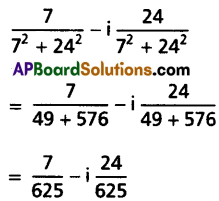
Question 2.
If Z1 = -1 and Z2 = +i, then find Arg(\(\frac{Z_1}{Z_2}\)).
Solution:
Given Z1 = -1
= -1 + i0
= cos π + i sin π
= cos π
∴ Arg (Z1) = π
Z2 = i
= 0 + i
= cos \(\frac{\pi}{2}\) + i sin \(\frac{\pi}{2}\)
= cos (\(\frac{\pi}{2}\))
∴ Arg (Z2) = \(\frac{\pi}{2}\)
Arg(\(\frac{Z_1}{Z_2}\)) = Arg (Z1) – Arg (Z2)
= π – \(\frac{\pi}{2}\)
= \(\frac{\pi}{2}\)
![]()
Question 3.
If 1, w, w2 are the cube roots of unity, prove that (1 – w + w2)6 + (1 – w2 + w)6 = 128.
Solution:
Given 1, w, w2 are the cube roots of unity.
∴ 1 + w + w2 = 0 and w3 = 1
L.H.S. = (1 – w + w2)6 + (1 – w2 + w)6
= (-w – w)6 + (-w2 – w2)6
= (-2w)6 + (-2w2)6
= 26 w6 + 26 w12
= 26 (w3)2 + 26 (w3)4
= 26 (1)2 + 26 (1)4
= 26 (1 + 1)
= 26 (2)
= 27
= 128
L.H.S. = R.H.S.
∴ (1 – w + w2)6 + (1 – w2 + w)6 = 27 = 128
Question 4.
If α, β are the roots of the equation ax2 + bx + c = 0, find the value of \(\frac{1}{\alpha^2}+\frac{1}{\beta^2}\) in terms of a, b, c.
Solution:
Given α, β are the roots of the equation ax2 + bx + c = 0
∴ α + β = \(\frac{-b}{a}\) and αβ = \(\frac{c}{a}\)
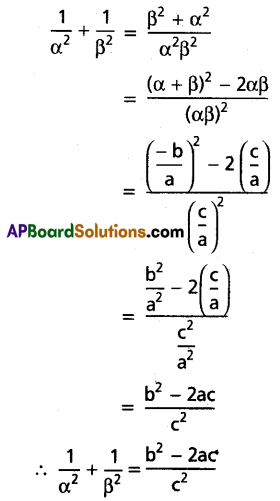
Question 5.
If the product of the roots of 4x3 + 16x2 – 9x – a = 0 is 9, then find a.
Solution:
Given the product of the roots of 4x3 + 16x2 – 9x – 9 = 0 is 9
⇒ \(\frac{-(-a)}{4}\) = 9
⇒ a = 36
Question 6.
Find the number of ways of preparing a chain with 6 different coloured beads.
Solution:
The number of ways of preparing a chain with 6 different coloured beads = \(\frac{1}{2}\)(6 – 1)!
= \(\frac{1}{2}\)(5!)
= \(\frac{1}{2}\)(120)
= 60 ways
Question 7.
If 12Cr+1 = 12C3r-5, find r.
Solution:
Given 12Cr+1 = 12C3r-5
⇒ r + 1 = 3r – 5 (or) 12 = r + 1 + 3r – 5
⇒ 6 = 2r (or) 12 = 4r – 4
⇒ r = 3 (or) 4r = 16
⇒ r = 3 (or) r = 4
![]()
Question 8.
Find the set of ‘x’ for which the binomial expansion of \((2+3 x)^{-\frac{2}{3}}\) is valid.
Solution:
\((2+3 x)^{-2 / 3}=2^{-2 / 3}\left(1+\frac{3 x}{2}\right)^{-2 / 3}\)
∴ The binomial expansion of \((2+3 x)^{-2 / 3}\) is valid when |\(\frac{3x}{2}\)| < 1
⇒ |x| < \(\frac{2}{3}\)
⇒ x ∈ \(\left(\frac{-2}{3}, \frac{2}{3}\right)\)
Question 9.
Define the “Range” for ungrouped data and also find the range of the given data:
38, 70, 48, 40, 42, 55, 63, 46, 54, 44
Solution:
Range: Range is defined as the difference between the maximum value and the minimum value of the series of observations.
Given data: 38, 70, 48, 40, 42, 55, 63, 46, 54, 44
Here Maximum value = 70
Minimum value = 38
∴ Range = 70 – 38 = 32
Question 10.
The probability that a person chosen at random is left-handed (in handwriting is 0.1. What is the probability that in a group of 10 people, there is one who is left-handed?
Solution:
Let X follow the binomial distribution with parameters n and p.
Here n = 10 and p = 0.1 = \(\frac{1}{10}\)
∴ p + q = 1
⇒ q = 1 – p
⇒ q = 1 – \(\frac{1}{10}\)
⇒ q = \(\frac{9}{10}\)
The probability that exactly one out of 10 is left-handed is P(X = 1) = \({ }^{10} C_1 p^1 q^{10-1}\)
= \({ }^{10} C_1\left(\frac{1}{10}\right)\left(\frac{9}{10}\right)^9\)
= \(10\left(\frac{1}{10}\right)(0.9)^9\)
= (0.9)9
Section – B
(5 × 4 = 20 Marks)
II. Short Answer Type Questions.
- Attempt any five questions.
- Each question carries four marks.
Question 11.
Show that the points in the Argand plane represented by the complex numbers -2 + 7i, \(\frac{-3}{2}+\frac{1}{2}i\), 4 – 3i, \(\frac{7}{2}\)(1 + i) are the vertices of a Rhombus.
Solution:
Let A, B, C, D be the points in the Argand plane.
∴ A = (-2, 7), B = \(\left(\frac{-3}{2}, \frac{1}{2}\right)\), C = (4, -3), D = \(\left(\frac{7}{2}, \frac{7}{2}\right)\)

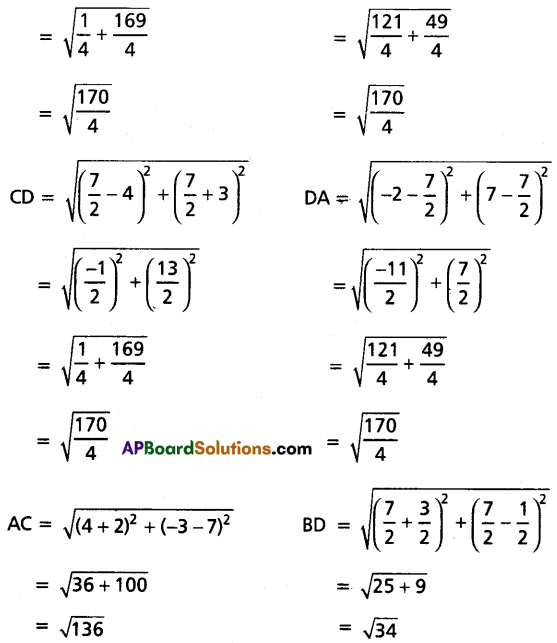
Here AB = BC = CD = DA and AC ≠ BD
∴ ABCD forms a rhombus.
![]()
Question 12.
Prove that \(\frac{1}{3 x+1}+\frac{1}{x+1}-\frac{1}{(3 x+1)(x+1)}\) does not lie in between 1 and 4, if x is real.
Solution:
Let y = \(\frac{1}{3 x+1}+\frac{1}{x+1}-\frac{1}{(3 x+1)(x+1)}\)
⇒ y = \(\frac{x+1+3 x+1-1}{(3 x+1)(x+1)}\)
⇒ y = \(\frac{4 x+1}{3 x^2+3 x+x+1}\)
⇒ y = \(\frac{4 x+1}{3 x^2+4 x+1}\)
⇒ 3yx2 + 4yx + 4 = 4x + 1
⇒ 3yx2 + (4y – 4)x + (y – 1) = 0
x ∈ R ⇒ (4y – 4)2 – 4(3y)(y – 1) ≥ 0
⇒ 16y2 – 32y + 16 – 12y2 + 12y ≥ 0
⇒ 4y2 – 20y + 16 ≥ 0
⇒ y2 – 5y – 4 ≥ 0
⇒ (y – 1) (y – 4) ≥ o
⇒ y ≥ 0 (or) y ≥ 4
∴ \(\frac{1}{3 x+1}+\frac{1}{x+1}-\frac{1}{(3 x+1)(x+1)}\) does not lie between 1 and 4.
Question 13.
If the letters of the word MASTER are permuted in all possible ways the words thus formed are arranged in the dictionary order, theft find the rank of the word MASTER.
Solution:
The alphabetical order of the letters of the word REMAST is A, E, M, R, S, T
The no.of words beginning with A is 5! = 120
The no.of words begin with E is 5! = 120
The no.of words begin with MAE is 3! = 6
The no.of words begin with MAR is 3! = 6
The no.of words begin with MASE is 2! = 2
The no.of words begin with MASRis 2! = 2
The next word is MASTER = 1
∴ Rank of the word MASTER = 120 + 120 + 6 + 6 + 2 + 2 + 1 = 257
Question 14.
A candidate is required to answer 6 out of 10 questions Which are divided into two groups A and B each containing 5 questions. He is not permitted to attempt more than 4 questions from either group. Find the number of different ways in which the candidate can choose six questions.
Solution:
The candidate can answer 4 questions from group A and 2 questions from group B (or) 3 questions from each group (or) 2 questions from group A and 4 questions from group B.
The number of ways of choosing questions by the candidate with
(i) 4 from group A and 2 from group B = 5C4 × 5C2 = 5 × 10 = 50
(ii) 3 from each group = 5C3 × 5C3 = 10 × 10 = 100
(iii) 2 from group A and 4 from group B = 5C2 × 5C4 = 10 × 5 = 50
∴ The number of ways of selecting 6 questions out of 10 questions is 50 + 100 + 50 = 200
Question 15.
Resolve \(\frac{x^4}{(x-1)(x-2)}\) into partial factions.
Solution:
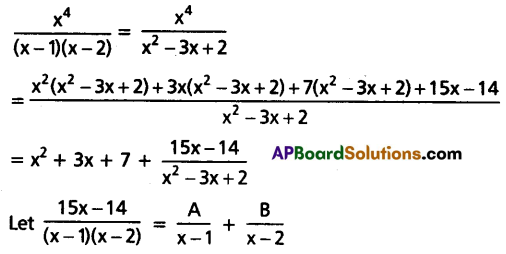
Equating the coefficients of (x – 1)(x – 2)
15x – 14 = A(x – 2) + B(x – 1)
Put x = 1, 15 – 14 = A(-1) ⇒ A = -1
Put x = 2, 30 – 14 = B(1) ⇒ B = 16
∴ \(\frac{x^4}{(x-1)(x-2)}=x^2+3 x+7-\frac{1}{x-1}+\frac{16}{x-2}\)
![]()
Question 16.
In a Committee of 25 members, each member is proficient either in mathematics statistics, or both. 19 of these are proficient in mathematics, and 16 in statistics. find the probability that a person selected from the committee is proficient in both.
Solution:
Let A be the event that the person is proficient in mathematics.
Let B be the event that the person is proficient in statistics.
When a person is chosen at random from the academy consisting of 25 members S is the sample space.
P(A) = \(\frac{19}{25}\), P(B) = \(\frac{16}{25}\)
Since everyone is either proficient in mathematics or statistics or in both.
∴ A ∪ B = S
⇒ P(A ∪ B) = P(S)
⇒ P(A) + P(B) – P(A ∩ B) = 1
⇒ P(A) + P(B) – 1 = P(A ∩ B)
⇒ P(A ∩ B) = \(\frac{19}{25}+\frac{16}{25}\) – 1
= \(\frac{19+16-25}{25}\)
= \(\frac{10}{25}\)
= \(\frac{2}{5}\)
∴ The probability that a person selected from the committee is proficient in both is \(\frac{2}{5}\).
Question 17.
A speaks truth in 75% of the cases and B in 80% of cases. What is the probability that their statements about an incident do not match?
Solution:
Let E1 and E2 be the events that A and B respectively speak, the truth about an incident.

If E is the event that their statements do not match about the incident, then this happens in two mutually exclusive ways.
(i) A speaks the truth and B tells a lie.
(ii) A tells a lie and B speaks the truth.
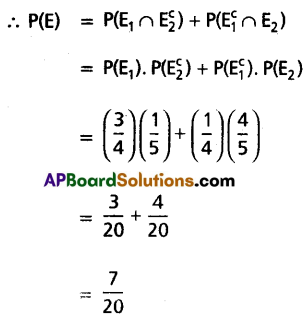
Section – C
(5 × 7 = 35 Marks)
III. Long Answer Type Questions.
- Attempt any five questions.
- Each question carries seven marks.
Question 18.
Show that one value of \(\left(\frac{1+\sin \frac{\pi}{8}+i \cos \frac{\pi}{8}}{1+\sin \frac{\pi}{8}-i \cos \frac{\pi}{8}}\right)^{\frac{8}{3}}\) is -1.
Solution:
\(\left(\frac{1+\sin \frac{\pi}{8}+i \cos \frac{\pi}{8}}{1+\sin \frac{\pi}{8}-i \cos \frac{\pi}{8}}\right)^{\frac{8}{3}}\)



Question 19.
Find the polynomial equation whose roots are the translates of the equation x5 – 4x4 + 3x2 – 4x + 6 = 0 by -3.
Solution:
Let f(x) = x5 – 4x4 + 3x2 – 4x + 6
The polynomial equation whose roots are the translates of the roots of the equation f(x) = 0 by -3 is f(x + 3) = 0
∴ (x + 3)5 – 4(x + 3)4 + 3(x + 3)2 – 4(x + 3) + 6 = 0
The transformed equation can be obtained by synthetic division.
Suppose that f(x + 3) = A0 x5 + A1 x4 + A2 x3 + A3 x2 + A4 x1 + A5
The coefficients A0, A1, A2, A3, A4, A5 can be obtained as follows.
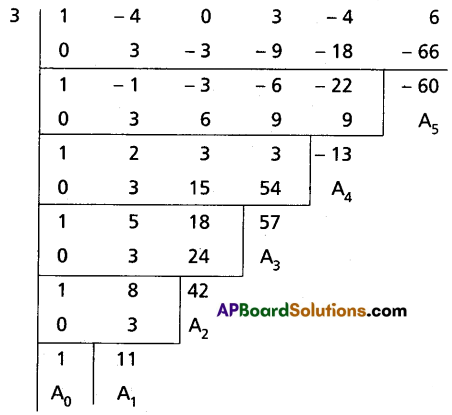
∴ Required equation is x5 + 11x4 + 42x3 + 57x2 – 13x – 60 = 0.
![]()
Question 20.
If the 2nd, 3rd, and 4th terms in the expansion of (a + x)n are respectively 240, 720, 1080, find a, x, n.
Solution:
Given 2nd, 3rd, and 4th terms in the expansion of (a + x)n are 240, 720, and 1080 respectively.
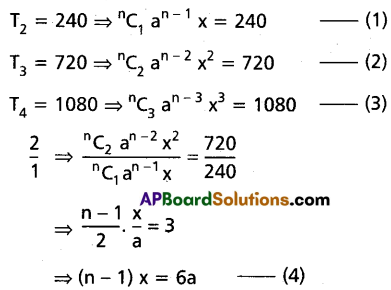
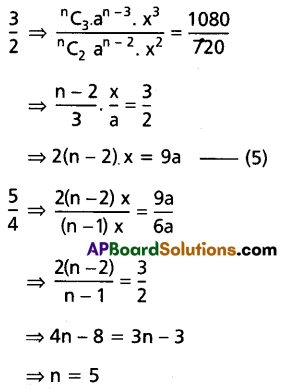
From (4), 4x = 6a ⇒ x = \(\frac{3a}{2}\)
From (1), \(5 C_1 a^4 \cdot \frac{3}{2} \cdot a\) = 240
⇒ 5(3a5) = 480
⇒ a5 = 32
⇒ a = 2
∴ x = \(\frac{3}{2}\)(2) = 3
∴ a = 2, x = 3, n = 5
Question 21.
If x = \(\frac{1.3}{3.6}+\frac{1.3 .5}{3 \cdot 6.9}+\frac{1 \cdot 3 \cdot 5.7}{3 \cdot 6 \cdot 9 \cdot 12}+\)……….., then prove that 9x2 + 24x = 11.
Question 22.
Find the mean deviation from the mean of the following data, using the step deviation method.
| Marks | 0-10 | 10-20 | 20-30 | 30-40 | 40-50 | 50-60 | 60-70 |
| Number of Students | 6 | 5 | 8 | 15 | 7 | 6 | 3 |
Question 23.
State and prove Baye’s theorem.
Solution:
Statement: Let E1, E2,……….., En be mutually exclusive and exhaustive events or a random experiment with P(Ei) ≠ 0 for i = 1, 2, 3,………, n. Then for any event A or the random experiment with P(A) ≠ 0.
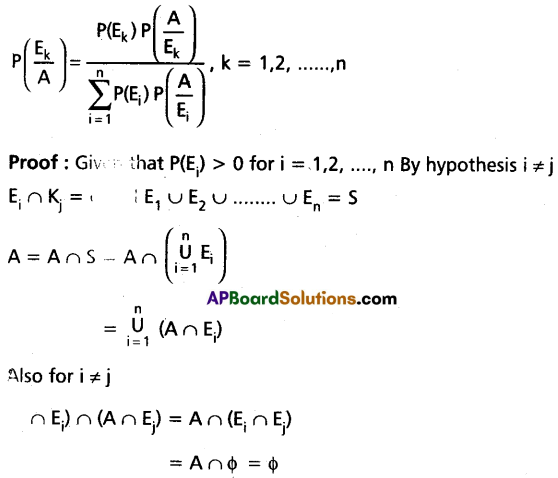
By multiplication theorem
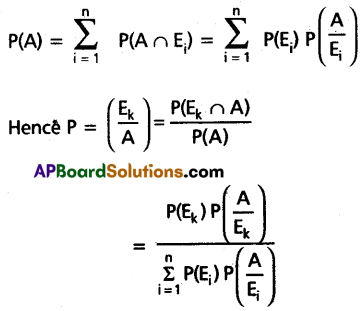
![]()
Question 24.
A random variable ‘X’ has the following probability distribution:
| X = x | 0 | 1 | 2 | 3 | 4 | 5 | 6 | 7 |
| P(X = x) | 0 | K | 2K | 2K | 3K | K2 | 2K2 | 7K2 + K |
Find:
(i) K
(ii) The Mean
(iii) P(0 < x < 5)
Solution:
We know P(X = x) = 1
⇒ P(X = 0) + P(X = 1) + P(X = 2) + P(X = 3) + P(X = 4) + P(X = 5) + P(X = 6) + P(X = 7) = 1
⇒ 0 + k + 2k + 2k + 3k + k2 + 2k2 + 7k2 + k = 1
⇒ 10k2 + 9k = 1
⇒ 10k2 + 9k – 1 = 0
⇒ 10k2 + 10k – k – 1 = 0
⇒ 10k(k + 1) – 1(k + 1) = 0
⇒ (k + 1)(10k – 1) = 0
⇒ k = -1 (or) k = \(\frac{1}{10}\)
(i) k = \(\frac{1}{10}\) Since k > 0
(ii) Mean = 0(P = 0) + 1P(X = 1) + 2P(X = 2) + 3P(X = 3) + 4P(X = 4) + 5P(X = 5) + 6P(X = 6) + 7P(X = 7)
= 0(0) + 1(k) + 2(2k) + 3(2k) + 4(3k) + 5(k2) + 6(2k2) + 7(7k2 + k)
= 0 + k + 4k + 6k + 12k + 5k2 + 12k2 + 49k2 + 7k
= 66k2 + 30k
= \(66\left(\frac{1}{10}\right)^2+30\left(\frac{1}{10}\right)\)
= 66(\(\frac{1}{100}\)) + 3
= 0.66 + 3
= 3.66
(iii) P(0 < x < 5) = P(X = 1) + P(X = 2) + P(X = 3) + P(X = 4)
= k + 2k + 2k + 3k
= 8k
= 8(\(\frac{1}{10}\))
= 0.8
∴ P(0 < x < 5) = 0.8